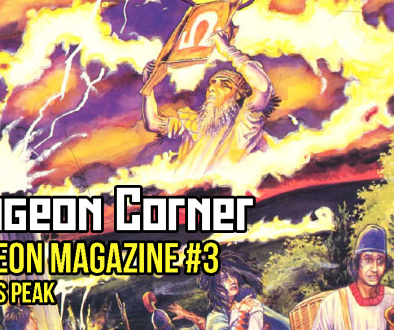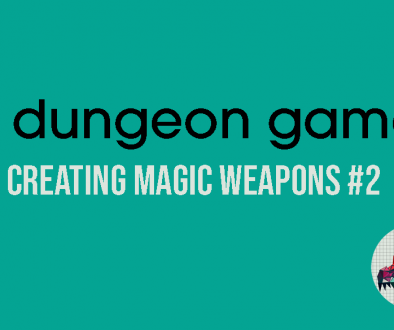Let’s Build A Campaign: The Railcrawl
Last week we talked about Points of Interest and Points of Encounters, drawing on some design techniques from CD Projekt Red’s The Witcher series to help add some linearity to the hex crawl. This week I want to expand on that a little bit, and look at how it might work in play.
I want to define some terms a little further in the context of this specific project, so that going forward I don’t have to keep explaining and clarifying things. I may end up using these terms a little differently to how they have been traditionally used. Just be aware of that.
First thing’s first are the two terms we already have – Points of Interest, and Points of Encounter. I’m actually going to wrap them both into the ‘Points of Interest’ label, and split that into two distinct kinds of PoI. These will be Points of Encounters (or Encounter Points) and Points of Discovery. These have the weird role of being both the most and least important sites in what I’m calling the Railcrawl.
Essentially, everything under the Points of Interest banner will be some kind of side quest, discovery, or ‘random’ encounter. These won’t necessarily drive the story forward, but they will all be designed to drip feed the party more information, and to give them more understanding of what is going on. They’ll probably also be used to provide the party with non-essential but useful tools; maybe they’ll find an ancient tome that gives a little more detail about the ritual they need to complete, making the final encounter easier, or maybe they’ll find a series of paintings that provide more information about what the elder god beneath the volcano actually is. Perhaps they can discover a lost treasure of the turtlekin, which might help them rebuild their bridges and thus have more support in the end-game.
These sites will be the things that encourage and reward exploration of the island, for the most part. They will also act as a pacing tool for the GM. We’ll get to that in a minute.
The second category of things I’m going to include will be Points of Story. These are the really important sites, the things that progress the plot of the campaign. Some of them – the turtlekin village, the ruined city, the nesting beaches – will be in predetermined positions on the map, but others will be placed in the same way as our PoIs – on the fly, as the GM sees fit.
I have this feeling that the Points of Story can also serve to provide aspirational views. The next Point of Story is, in general, the target that the party intend to head towards. They might not always be visible – that is, the term ‘aspirational view’ might not always apply. Rather, the party might find a fragment of an old map that will lead them to the swamp temple where they will learn about the ritual, or something like that. Along the way they’ll encounter our Points of Interest, have side-adventures, and do some levelling. And once they reach the Point of Story they were aiming for, we’ll seed the next one.
I’m wondering, too, whether to make the Points of Interest that can appear dependant on the Point of Story the party are working towards. This goes back to node-based scenario design, and particularly the inverted three-clue rule; each PoI will provide clues that point both towards the next POS, but also to either the one after that or to the next set of PoIs. Each PoS will provide clues that lead to the next set of PoIs. Really, I’m building a series of funnels. And really, there’s not a huge amount of difference in what I’m trying to do here and what was described in those articles on node-based design that I keep linking to. In fact, after spending a week playing around with how to design this thing, I ended up with this poorly-drawn diagram:
And that looks rather a lot like the funnel system in this post.
So, really, I’ve put a lot of effort into designing something that The Alexandrian defined for us 7 years ago. If you look closely you’ll see that I’ve tried to seed some of the later PoIs in earlier ones, giving clues that won’t pay off until much later, but I’m not sure there’s a need for that. I think the funnel system will work for me without needing to be changed in that way.
That’s not to say that this has been wasted effort, though. Even if I’ve essentially built something that somebody else has already designed, I always find that figuring things out for yourself rather than simply taking a template provided by somebody else makes for much more rewarding work. When you design something yourself you understand it on a much deeper level, and that makes it much easier to use those tools in interesting ways.
And even if this has been largely wasted effort, spelling out exactly how I’m going to use and present these nodes is definitely going to be of use to me. I know that each central node (or junction. I’m going to call them junctions, because I decided to call it a railcrawl and railways have junctions) is going to be an important story event. These will be where the big dungeons and encounters live.
The other nodes – the stations? No. That’s stretching the metaphor so far that it breaks – will be for smaller encounters and discoveries. In practice, a group could probably cover a few of the PoI nodes in one session, whereas a junctional node may cover a couple of sessions of play.
I mentioned earlier that the PoIs will be useful for pacing. The GM – and the party, to some extent – will always know what the next junctional node will be. They can place these additional nodes as they see fit, allowing the party to gather resources and information and XP before heading to that junction fully equipped to deal with it. Or, if they’re feeling like things are bogging down, they can simply funnel the players straight to the next junction by dropping it in the hex that they’re in.
In order to minimise unused content, I may work on designing a system so that these PoIs can be used at any point in the campaign. The information gained at each of these PoIs may well vary depending on which junction the party is heading towards. This will mean that the GM has a pool of potential encounter sites that she can drop into the game at any point, and it will mean that anything that doesn’t get used in the early game isn’t just going to sit and gather dust. There will always be a use for the PoIs, in theory, even if the party don’t go looking for them.
One thing I may have issues with if I’m not careful is that of GMs not knowing what will be in the next hex. I’ve already said that I like the idea of using aspirational views to drive exploration,but if the GM doesn’t know what is in the next hex until it is uncovered, then she can’t describe what the players see. This is probably solvable within the system. Especially in jungle terrain, sightlines are going to be reduced anyway, and an aspirational ‘view’ doesn’t have to be quite so literal as “you see a tower above the trees”.
Going back to that NoClip video I talked about last time, the developers of The Witcher talked explicitly about aspirational views. Rather than dotting their map with lots of tall, interesting things – the kind of level design you see in Ubisoft open world games like Assassin’s Creed, for example – they would place one or two physical landmarks that were visible from a great distance, then fill the landscape in between with smaller sites to uncover. That seems like a workable solution. If I’m placing a number of sites that will always be in the same place, then the almanac for each hex could detail which of those sites are visible from within that hex and in what way.
I did want to get a small sample scenario written up for this week, but I ended up spending a lot of time reading Perilous Wilds for Dungeon World at the suggestion of one of my patrons. If you’ve looking to run a wilderness campaign you could do a lot worse than to look at how that book handles exploration. Rather than building things for this setting I ended up just reading that over and over again, mining it for ideas and systems. I’m hoping to have something a little more concrete to show you for next week; I think I’m reaching a point with this project where I can start building things again, now that a lot of this more philosophical design work has been done.
So, that’s where we’re up to. Thanks for reading, and thanks for your patience with this series. I never expected this project to move particularly quickly, but personally I’m about ready to start producing some actual playable content. We’ll see how that goes.







October 20, 2017 @ 6:13 pm
I find this whole process really fascinating. It feels like you’re on track to end up with a really fun and creative product.
My only thought at this point is that it’s starting to feel a lot more like an adventure book than a campaign setting. Just comparing it to the Tal’Dorei Campaign Setting (as it’s the most recent I’ve read through), there’s not a single note of any kind of adventure process. It’s literally just information about the world, and includes the mechanical bits that go with it: new PC backgrounds, monster/enemy stat blocks, magic items, etc.
Do you still think “Campaign Setting” is the best title for what you’re making?
October 22, 2017 @ 7:23 pm
I also find these to be fascinating reads every time! I like seeing how the campaign is being forged and built up. And railcrawl is a neat description for what you are building here! I always think that ‘railroading’ is a strange description of a single track adventure; railways are really complex with hundreds of junctions!
I will take a look at Perilous Wilds, but I would also recommend you check out Critical Hit Publishing’s ‘Cinematic Environs: Survival’ – http://www.drivethrurpg.com/m/product/208668. It takes a really cool look at making travel challenging and interesting for your players.
November 9, 2017 @ 12:34 pm
OK, I’m caught up (for now). And I think I’ve realized the difference between your drive to ‘not have anything published that isn’t used at the gaming table’ and my shared distaste for “random encounters.” Let me describe the difference.
For you, it’s waste you’re trying to avoid. For me it’s the lack of logic or meaning that makes it unsatisfying as a GM/storyteller. I’m going to steal from the railroad metahpor that seems so prevalent. I would like to imagine your island as a model train environment. The turtlekin (I think I called them tortizens 😉 You can have that for free) run on a circuit around the island, living in the south, mating in the north like a model train running around the terrain. Inside are many moving gears and wheels within wheels. Little scenes with toy cars moving around a small town, people shopping, living their lives with their own motivations that make them act within the environment. With that model, the party is simply encountering existing wheels in motion. There aren’t “wandering monsters” they are going somewhere, they are fleeing a predator, they are searching for lunch. They have purpose and meaning. The party is interposing themselves into an existing environment that would run just fine without them, and their busting that cycle is the definition of the drama of story – and that’s the fun we’re all craving. environment >> disruption >> resolution = story
So with my view, there would be many pieces that wouldn’t see table play, but with those gears whirring on the inside, what is seen is realistic, fun, and can be opened up for the players that like to “take things apart to see how they work.” That’s the kind of campaign I’m trying to put together myself – only I’m dealing with trading bands, economics, and how trade drives kingdoms and eventually conquest and conflict. But mine is too big a bite to chew and I’ve really enjoyed how you’ve honed it down by taking smaller chunks without the “mysterious mist” to enclose it all.
Keep going, this is very enlightening. And enlightening = entertaining.
Let’s Build A Campaign: Talking Turtlekin – Loot The Room
January 22, 2018 @ 11:01 am
[…] When I left off I was talking about something akin to a procedurally-generated hex crawl system, where I would populate the map with a couple of static sites and then build a system to allow GMs to quickly populate the rest of the map themselves with other pre-built Points of Discovery (PoD) and Points of Story (PoS) as the players explore. When stated like that it seems quite a large task, but as with any large creative project we can easily break this down into smaller chunks that add together into the more complex whole. So, let’s begin by seeing what kind of chunks we can break this task into. […]